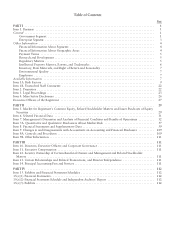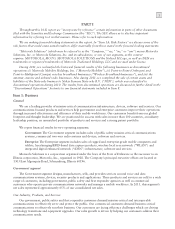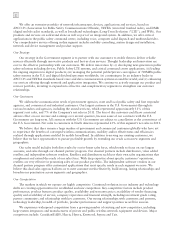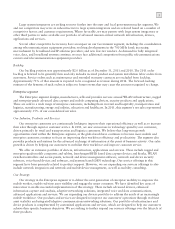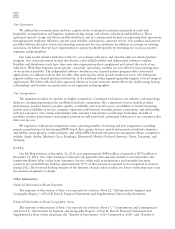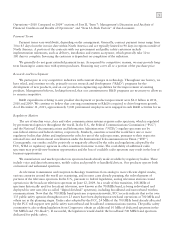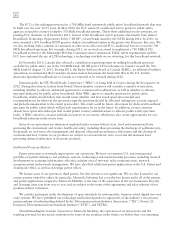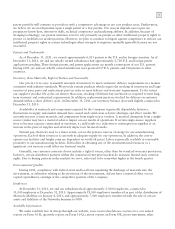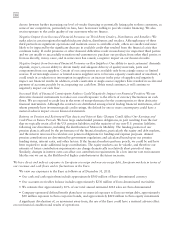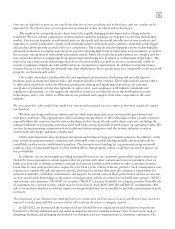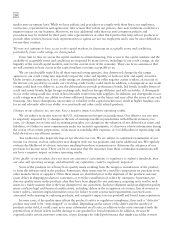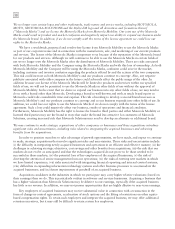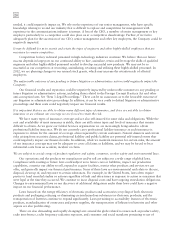Motorola 2011 Annual Report Download - page 16
Download and view the complete annual report
Please find page 16 of the 2011 Motorola annual report below. You can navigate through the pages in the report by either clicking on the pages listed below, or by using the keyword search tool below to find specific information within the annual report.
10
choose between further increasing our level of vendor financing or potentially losing sales to these customers, as
some of our competitors, particularly in Asia, have been more willing to provide vendor financing. We also
retain exposure to the credit quality of our customers who we finance.
Negative Impact from Increased Financial Pressures on Third-Party Dealers, Distributors and Retailers: We
make sales in certain regions through third-party dealers, distributors and retailers. Although many of these
third parties have significant operations and maintain access to available credit, others are smaller and more
likely to be impacted by the significant decrease in available credit that resulted from the financial crisis that
continues today. If credit pressures or other financial difficulties result in insolvency for important third parties
and we are unable to successfully transition end-customers to purchase our products from other third parties or
from us directly, it may cause, and in some cases has caused, a negative impact on our financial results.
Negative Impact from Increased Financial Pressures on Key Suppliers: Our ability to meet customers’ demands
depends, in part, on our ability to obtain timely and adequate delivery of quality materials, parts and
components from our suppliers. Certain of our components are available only from a single source or limited
sources. If certain single-source or limited-source suppliers were to become capacity constrained or insolvent, it
could result in a reduction or interruption in supplies or an increase in the price of supplies and negatively
impact our financial results. In addition, credit constraints at single-source suppliers have resulted in accelerated
payment of accounts payable by us, impacting our cash flow. If this trend continues, it will continue to
negatively impact our cash flow.
Increased Risk of Financial Counterparty Failures Could Negatively Impact our Financial Position: We use
derivative financial instruments to reduce our overall exposure to the effects of currency fluctuations on cash
flows. We are exposed to credit loss in the event of nonperformance by the counterparties to these derivative
financial instruments. Although the contracts are distributed among several leading financial institutions, all of
whom presently have investment grade credit ratings, the default by one or more counterparty could have a
material adverse impact on our financial statements.
Returns on Pension and Retirement Plan Assets and Interest Rate Changes Could Affect Our Earnings and
Cash Flow in Future Periods: We have large underfunded pension obligations, in part resulting from the fact
that we typically retain all of the U.S. pension liabilities and the majority of our non-U.S. pension liabilities
following our divestitures, including the distribution of Motorola Mobility. The funding position of our
pension plans is affected by the performance of the financial markets, particularly the equity and debt markets,
and the interest rates used to calculate our pension obligations for funding and expense purposes. Annual
pension contributions are determined by government regulations and calculated based upon our pension
funding status, interest rates, and other factors. If the financial markets perform poorly, we could be and have
been required to make additional large contributions. The equity markets can be volatile, and therefore our
estimate of future contribution requirements can change dramatically in relatively short periods of time.
Similarly, changes in interest rates can affect our contribution requirements. In a low interest rate environment
like the one we are in, the likelihood of higher contributions in the future increases.
We have direct and indirect exposure to European sovereign and non-sovereign debt, European markets in terms of
our revenues and cash flows and to fluctuations in the Euro.
We view our exposures to the Euro as follows as of December 31, 2011:
• Our cash and cash equivalents include approximately $300 million of Euro denominated currency
• Our accounts receivables balance includes approximately $230 million of Euro denominated receivables
• We estimate that approximately 10% of our total annual estimated 2012 sales are Euro denominated
• Company-sponsored defined benefit plans have no material exposure to Euro sovereign debt, approximately
$50 million exposure to Euro corporate bonds, and approximately $220 million to Euro equity investments
A significant devaluation of, or movement away from, the use of the Euro could have a material adverse effect
on our financial condition and results of operations.


